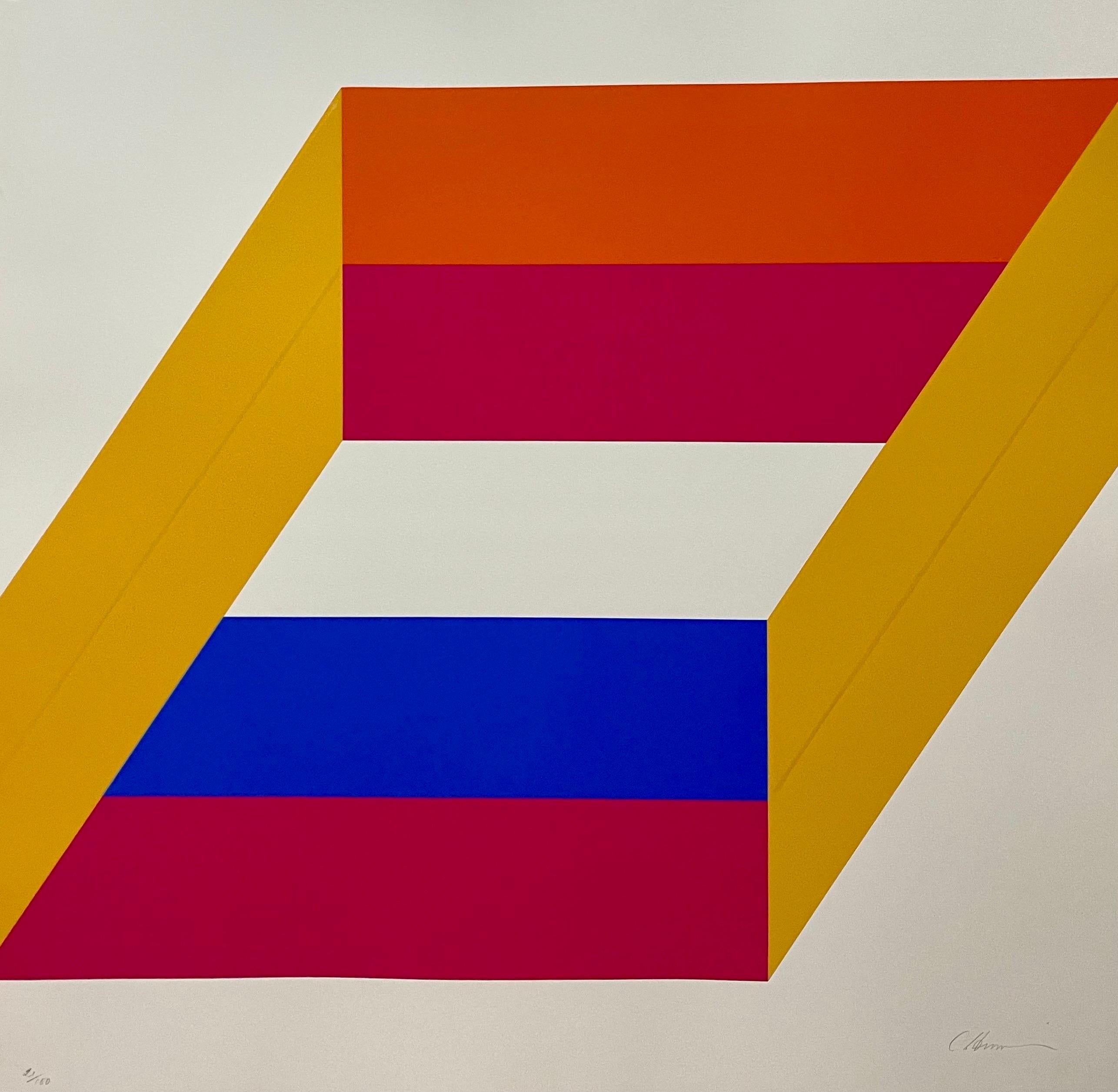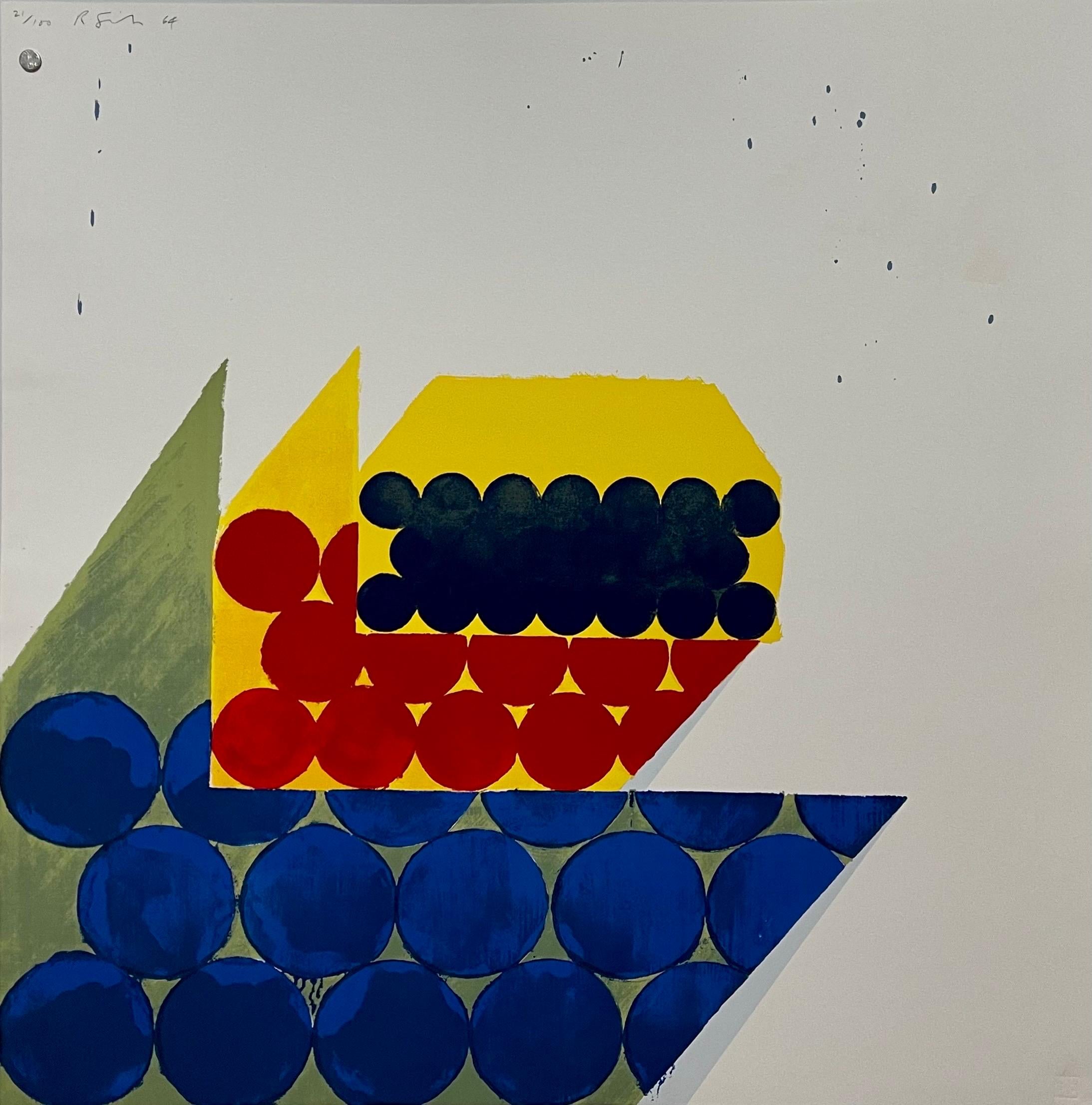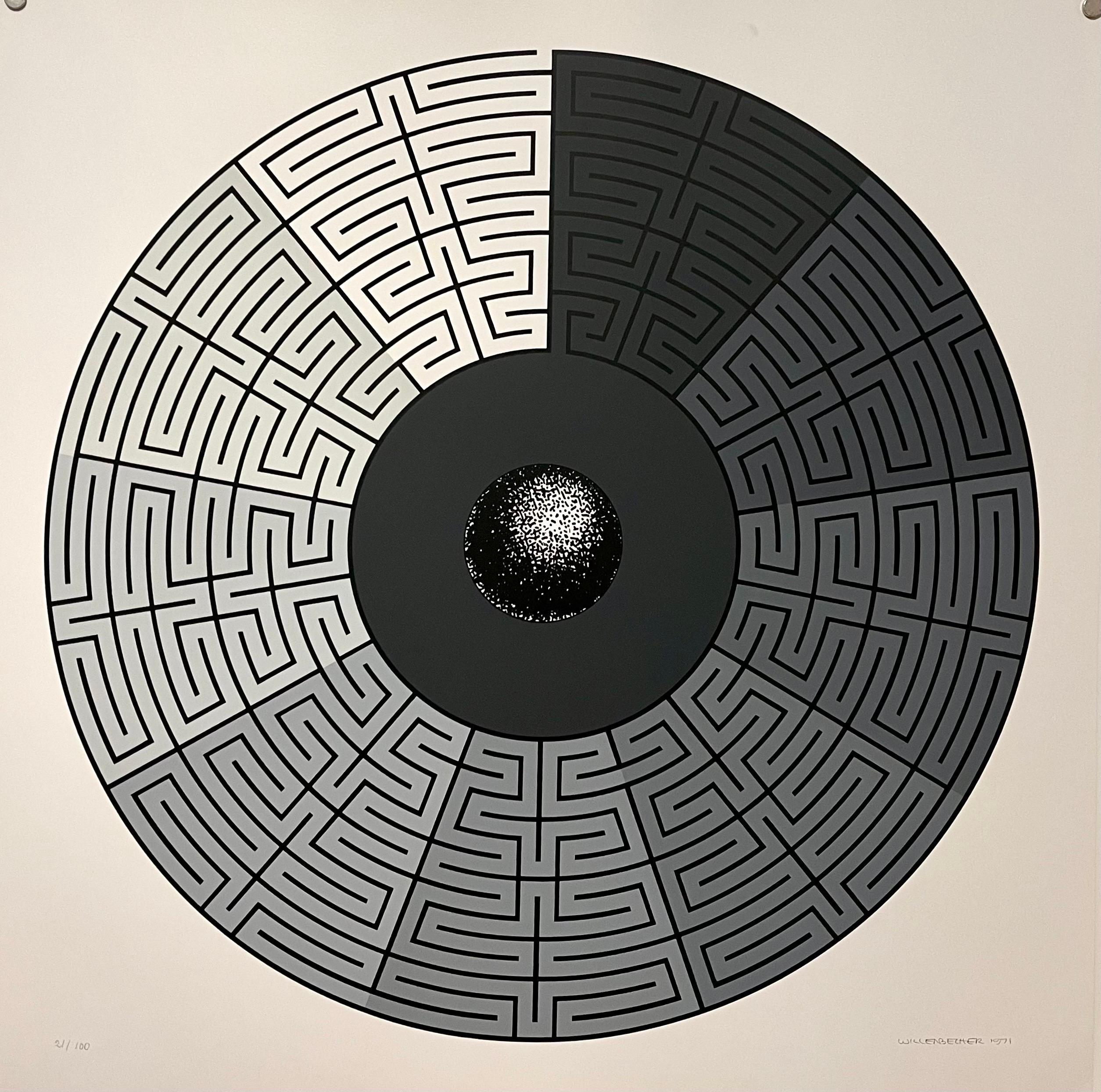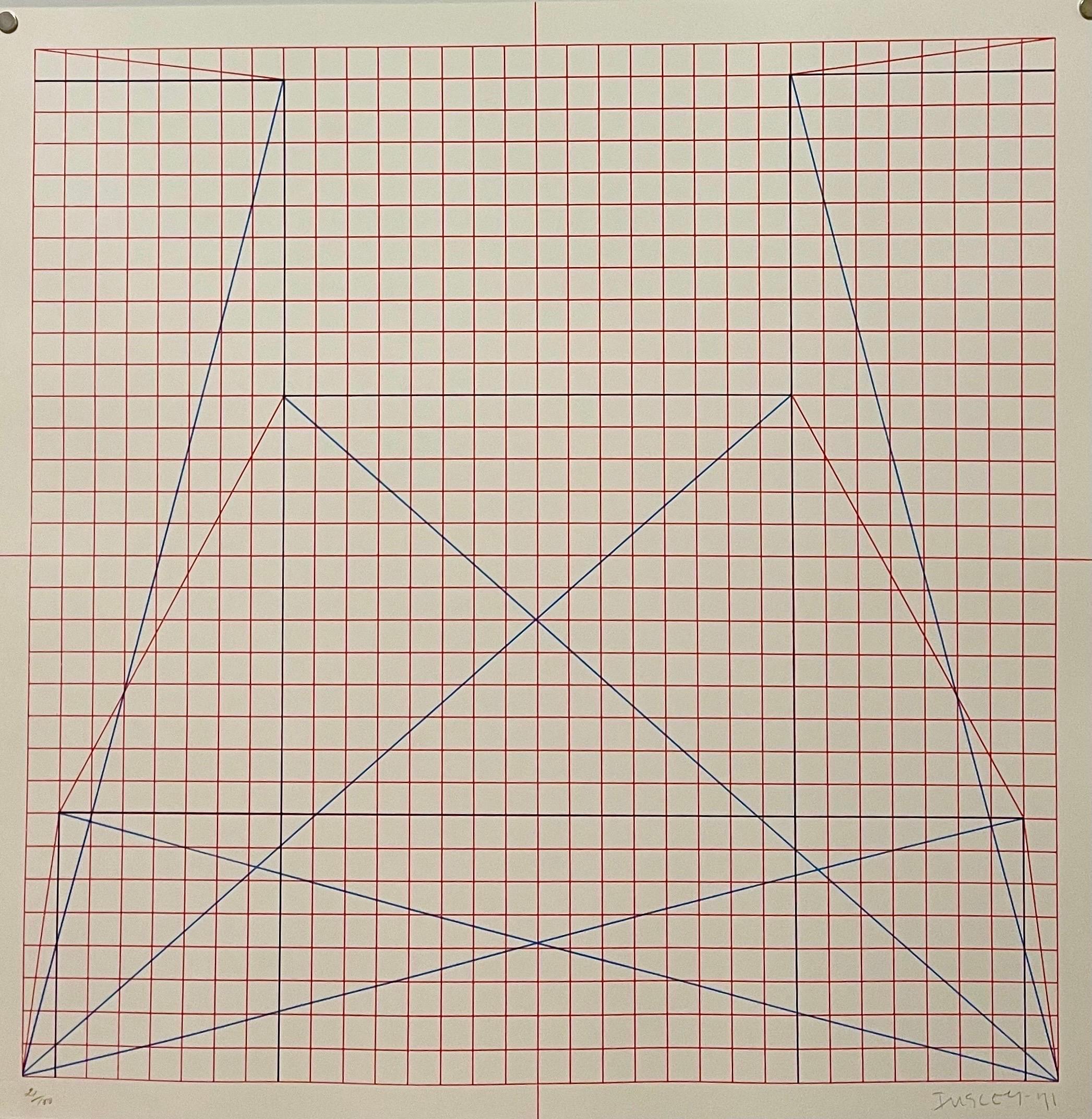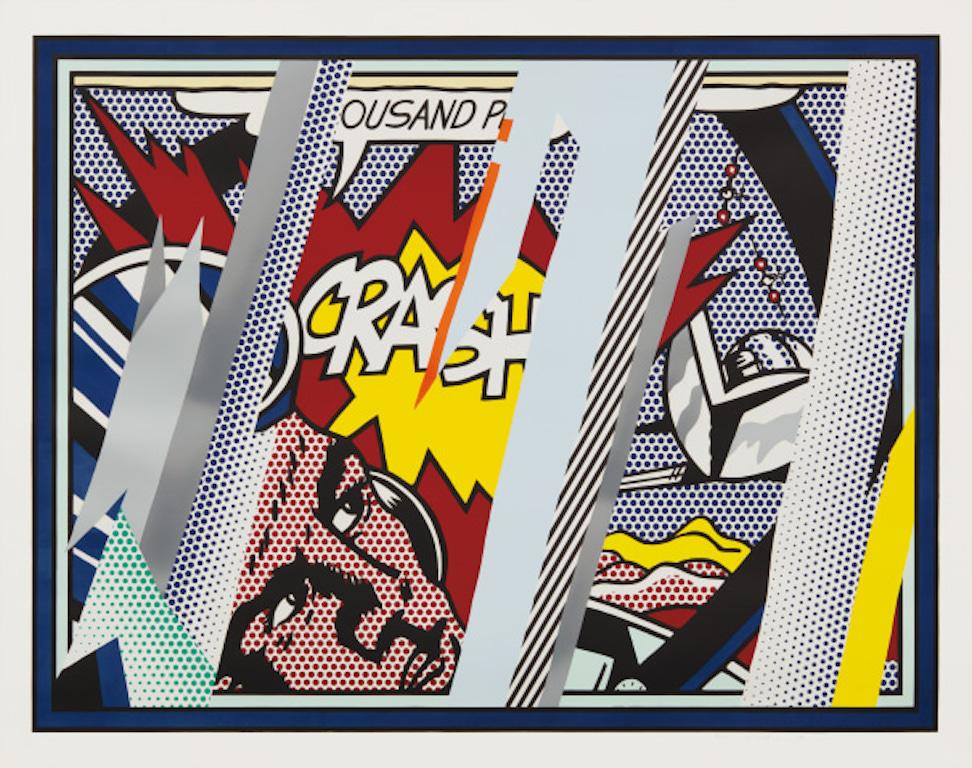Items Similar to Color Silkscreen Pop Art Lithograph Print Les Levine Canadian Pop Art Portrait
Want more images or videos?
Request additional images or videos from the seller
1 of 8
Les LevineColor Silkscreen Pop Art Lithograph Print Les Levine Canadian Pop Art Portrait1969-1971
1969-1971
About the Item
Les Levine
On the Bowery, 1969 - 1971
Screenprint in color
25.5 x 25.5 inches, signed, numbered 21/100
Hand signed, published by Edition Domberger, Bonlanden, West Germany (with their blindstamp)
Provenance: Collection of Tom Levine
On the Bowery, 1971. The portfolio consists of nine screenprints in colors (one with mylar collage), on wove paper, by representative artists of the Pop Art period. Cy Twombly, Robert Ryman, Will Insley, Robert Indiana, Les Levine, John Willenbecher, Charles Hinman, Richard Smith, Gerald Laing, and John Giorno. The ten artists were photographed by Eliot Elisofon (1911-1973), who also lived on the Bowery and was a founding member of the Photo League in 1936.
In the late 40s and 50s Clyfford Still, Mark Rothko, Fernand Leger and Jean Dubuffet, among others, had studios on the Bowery, and Willem de Kooning, Franz Kline and Reginald Marsh worked nearby. In the early 60s, Louise Nevelson took a place on Mott Street just off the Bowery and was joined not long after by other artists attracted by the lofts for reasonable rents and the relaxed, small-time quality of the area. - William Katz, from the introduction for the portfolio.
Among other artists, writers and photographers who have lived or worked there are: Arman, Jack Brusca, Larry Calcagno, Pierre Clerk, Tom Doyle, Jean Dupuy, Janet Fish, Robert Frank, Adolph Gottlieb, Eva Hesse, Roy Lichtenstein, Jay Maisel, Ed Meneeley, Malcolm Morley, Kenneth Noland, Angelo Savelli, and Tom Wesselmann.
Les Levine (born 1935) is a naturalized American Irish artist known as a pioneer of video art and as a conceptual artist working with mass communication. In 1967, Levine won first prize for sculpture in the Canadian Sculpture Biennial.
A graduate of the Central School of Art and Design in London, Levine first moved to Canada in 1960. He eventually settled in New York City in 1964 and became a resident artist at the Nova Scotia College of Art and Design in Halifax, Nova Scotia in 1973. Early in his career, Levine introduced the idea of a disposable art and was given the nickname Plastic Man. In 1965, Levine, with Nam June Paik, were among the first artists to buy and use portapaks. Thus he was one of the first artists to try television as a medium for the dissemination of art. He has also used the telephone for this purpose, as well. In 1969 he exhibited White Sight at the Fischbach Gallery, a work consisting of a room as the inside of a featureless white cube illuminated by two bright sodium vapour lights. This meant that the spectator was confronted with their own act of looking presented as an artifact. The installation was also included as a feature for a charity ball at the New York Museum of Modern Art, to attend which museum patrons had to pay $75 per couple. Whilst Levine regarded the installation as a great success, this view was not shared by all the patrons. The yellow light drained the women's dresses of color. One visitor said: "All the men looked as if they have been dead for two centuries. All the women looked like their grandmothers. The beautiful ladies fled within one minute." One of these accused Levine of making the museum "look ugly and silly" and promptly transformed the artwork by pulling the main light switch. In 1984, Levine produced the short film Made in New York in collaboration with fashion designer Willi Smith. He also designed a T-shirt for Smith’s label WilliWear Productions that was featured in the film. Levine has written on art for Arts, The Village Voice, Art in America and the Saturday Review. He was awarded the National Endowment for the Arts Fellowship in 1974 and again in 1980.
Reference material
Expanded Cinema by Gene Youngblood (pp. 337–344). Beyond Modern Sculpture by Jack Burnham, The Britannica Encyclopedia of American Art Simon Schuster, Art and the Future by Douglass Davis, Science and Technology in the Arts by Stewart Kranz, Innovative Printmaking by Theima P. Newman and On Photography by Susan Sontag.
- Creator:Les Levine (1935, Canadian)
- Creation Year:1969-1971
- Dimensions:Height: 25.5 in (64.77 cm)Width: 20.5 in (52.07 cm)
- Medium:
- Movement & Style:
- Period:
- Condition:good. minor wear. never framed. kept in original portfolio.
- Gallery Location:Surfside, FL
- Reference Number:1stDibs: LU38210286052
About the Seller
4.9
Platinum Seller
These expertly vetted sellers are 1stDibs' most experienced sellers and are rated highest by our customers.
Established in 1995
1stDibs seller since 2014
1,565 sales on 1stDibs
Typical response time: 1 hour
- ShippingRetrieving quote...Ships From: Surfside, FL
- Return PolicyA return for this item may be initiated within 3 days of delivery.
More From This SellerView All
- 1969-71 Abstract Minimalist Color Silkscreen Print Charles Hinman On The BoweryBy Charles HinmanLocated in Surfside, FLCharles Hinman On the Bowery, 1969 - 1971 silkscreen on Schoeller's Parole Paper, edition of 100 + 20 A.P. 25.5 x 25.5 inches, signed, numbered 21/100 Screenprint in color on wove paper Hand signed, published by Edition Domberger, Bonlanden, West Germany (with their blindstamp) Provenance: Collection of Tom Levine On the Bowery, 1971. The portfolio consists of nine screenprints in colors (one with mylar collage), on wove paper, by representative artists of the Pop Art period. Cy Twombly, Robert Ryman, Will Insley, Robert Indiana, Les Levine, John Willenbecher...Category
1960s Pop Art Abstract Prints
MaterialsScreen, Lithograph
- Abstract Minimalist Color Silkscreen Print Richard Smith On The Bowery Pop ArtBy Richard SmithLocated in Surfside, FLRichard Smith On the Bowery, 1969 - 1971 silkscreen on Schoeller's Parole Paper, edition of 100 + 20 A.P. 25.5 x 25.5 inches, signed, numbered 21/100 Screenprint in color on wove paper Hand signed, published by Edition Domberger, Bonlanden, West Germany (with their blindstamp) Provenance: Collection of Tom Levine On the Bowery, 1971. The portfolio consists of nine screenprints in colors (one with mylar collage), on wove paper, by representative artists of the Pop Art period. Cy Twombly, Robert Ryman, Will Insley, Robert Indiana, Les Levine, John Willenbecher...Category
1960s Pop Art Abstract Prints
MaterialsLithograph, Screen
- Abstract Minimalist Color Silkscreen Print John Willenbecher The Bowery Pop ArtLocated in Surfside, FLJohn Willenbecher On the Bowery, 1969 - 1971 silkscreen on Schoeller's Parole Paper, edition of 100 + 20 A.P. 25.5 x 25.5 inches, signed, numbered 2...Category
1960s Pop Art Abstract Prints
MaterialsLithograph, Screen
- Abstract Minimalist Color Silkscreen Print Will Insley On The Bowery Pop ArtLocated in Surfside, FLWill Insley On the Bowery, 1969 - 1971 silkscreen on Schoeller's Parole Paper, edition of 100 + 20 A.P. 25.5 x 25.5 inches, signed, numbered 21/100 Screenprint in color on wove paper Hand signed, published by Edition Domberger, Bonlanden, West Germany (with their blindstamp) Provenance: Collection of Tom Levine On the Bowery, 1971. The portfolio consists of nine screenprints in colors (one with mylar collage), on wove paper, by representative artists of the Pop Art period. Cy Twombly, Robert Ryman, Will Insley, Robert Indiana, Les Levine, John Willenbecher...Category
1960s Pop Art Abstract Prints
MaterialsLithograph, Screen
- Joe Tilson British Pop Art Screenprint, Color Lithograph 4 Seasons 4 ElementsBy Joe TilsonLocated in Surfside, FLSilkscreen screenprint or Lithograph Hand signed and numbered. An esoteric, mystical, Kabbala inspired print with Hebrew as well as other languages. Joseph Charles Tilson RA (born 2...Category
1970s Pop Art Abstract Prints
MaterialsLithograph, Screen
- Judy Rifka Abstract Expressionist Contemporary Lithograph Hebrew 10 CommandmentBy Judy RifkaLocated in Surfside, FLJudy Rifka (American, b. 1945) 44/84 Lithograph on paper titled "Thou Shalt Not Bear False Witness against Thy Neighbor"; Depicting an abstract composition in blue, green, red and black tones with Hebrew script. Judaica interest. (I have seen this print described as a screenprint and as a lithograph) Hand signed in pencil and dated alongside an embossed pictorial blindstamp of a closed hand with one raised index finger. Solo Press. From The Ten Commandments Kenny Scharf; Joseph Nechvatal; Gretchen Bender; April Gornik; Robert Kushner; Nancy Spero; Vito Acconci; Jane Dickson; Judy Rifka; Richard Bosman and Lisa Liebmann. Judy Rifka (born 1945) is an American woman artist active since the 1970s as a painter and video artist. She works heavily in New York City's Tribeca and Lower East Side and has associated with movements coming out of the area in the 1970s and 1980s such as Colab and the East Village, Manhattan art scene. A video artist, book artist and abstract painter, Rifka is a multi-faceted artist who has worked in a variety of media in addition to her painting and printmaking. She was born in 1945 in New York City and studied art at Hunter College, the New York Studio School and the Skowhegan School of Painting and Sculpture in Maine. Rifka took part in the 1980 Times Square Show, (Organized by Collaborative Projects, Inc. in 1980 at what was once a massage parlor, with now-famous participants such as Jenny Holzer, Nan Goldin, Keith Haring, Kenny Scharf, Jean-Michel Basquiat, and Kiki Smith, the roster of the exhibition reads like a who’s who of the art world), two Whitney Museum Biennials (1975, 1983), Documenta 7, Just Another Asshole (1981), curated by Carlo McCormick and received the cover of Art in America in 1984 for her series, "Architecture," which employed the three-dimensional stretchers that she adopted in exhibitions dating to 1982; in a 1985 review in the New York Times, Vivien Raynor noted Rifka's shift to large paintings of the female nude, which also employed the three-dimensional stretchers. In a 1985 episode of Miami Vice, Bianca Jagger played a character attacked in front of Rifka's three-dimensional nude still-life, "Bacchanaal", which was on display at the Museum of Art Fort Lauderdale. Rene Ricard wrote about Rifka in his influential December 1987 Art Forum article about the iconic identity of artists from Van Gogh to Jean-Michel Basquiat and Keith Haring, The Radiant Child.The untitled acrylic painting on plywood, in the collection of the Honolulu Museum of Art, demonstrates the artist's use of plywood as a substrate for painting. Artist and writer Mark Bloch called her work "imaginative surfaces that support experimental laboratories for interferences in sensuous pigment." According to artist and curator Greg de la Haba, Judy Rifka's irregular polygons on plywood "are among the most important paintings of the decade". In 2013, Rifka's daily posts on Facebook garnered a large social media audience for her imaginative "selfies," erudite friendly comments, and widely attended solo and group exhibitions, Judy Rifka's pop art figuration is noted for its nervous line and frenetic pace. In the January 1998 issue of Art in America, Vincent Carducci echoed Masheck, “Rifka reworks the neo-classical and the pop, setting all sources in quotation for today’s art-world cognoscenti.” Rifka, along with artists like David Wojnarowicz, helped to take Pop sensibility into a milieu that incorporated politics and high art into Postmodernism; Robert Pincus-Witten stated in his 1988 essay, Corinthian Crackerjacks & Passing Go that "Rifka’s commitment to process and discovery, doctrine with Abstract Expressionist practice, is of paramount concern though there is nothing dogmatic or pious about Rifka’s use of method. Playful rapidity and delight in discovery is everywhere evident in her painting." In 2016, a large retrospective of Rifka's art was shown at the Jean-Paul Najar Foundation in Dubai. In 2017, Gregory de la Haba presented a Rifka retrospective at the Amstel Gallery in The Yard, a section of Manhattan described as "a labyrinth of small cubicles, conference rooms and small office spaces that are rented out to young entrepreneurs, professionals and hipsters". In 2019 her video Bubble Dancers New Space Ritual was selected for the International Istanbul Bienali. Alexandra Goldman Talks To Judy Rifka About Ionic Ironic: Mythos from the '80s at CORE:Club and the Inexistence of "Feminist Art" Whitehot Magazine of Contemporary Art. She was included in "50 Contemporary Women Artists", a book comprising a refined selection of current and impactful artists. The foreword is by Elizabeth Sackler of the Brooklyn Museum’s Sackler Center for Feminist Art. Additional names in the book include sculptor and carver Barbara Segal...Category
1980s Pop Art Abstract Prints
MaterialsLithograph, Screen
You May Also Like
- Reflections on CrashBy Roy LichtensteinLocated in New York, NY1990 Lithograph, screenprint on paper and metalised PVC on paper S. 59 1/8 x 75 in. (150.2 x 190.5 cm) Edition of 68 Signed, dated and numbered in pencil, lower marginCategory
1990s Pop Art Abstract Prints
MaterialsPaper, Lithograph, Screen
- Bicentennial, by Roy LichtensteinBy Roy LichtensteinLocated in New York, NYIncluded in America: The Third Century portfolio, Roy Lichtenstein created Bicentennial as an original color lithograph with screenprint in 1975, conceived to celebrate the 200th ann...Category
20th Century Pop Art More Prints
MaterialsLithograph, Screen
- Democratic Party Human Rights Dinner (signed Pop Art print edition of only 100)By Robert RauschenbergLocated in New York, NYRobert Rauschenberg Human Rights Award, 1981 Silkscreen and Lithograph with Collage Embossing on Hodgkins Handmade Paper Pencil signed and numbered 73/100 on the front Silkscreen and Lithograph with Collage Embossing on Hodgkins Handmade Paper Published by the Democratic Party...Category
1980s Pop Art Abstract Prints
MaterialsLithograph, Screen, Pencil
- Blue FaceBy Roy LichtensteinLocated in New York, NYA stunning example of abstracted imagery easily identifiable as the work of Roy Lichtenstein, Blue Face was created by the artist in 1989 as a truly mixed me...Category
20th Century Pop Art Abstract Prints
MaterialsLithograph, Screen, Woodcut
- Study of HandsBy Roy LichtensteinLocated in New York, NYCreated in 1981 as an original lithograph with screen-printing, Roy Lichtenstein’s, Study of Hands is hand-signed in pencil, dated and numbered, measuring 31 ¼ x 32 ¾ in. (79.5 x 83....Category
20th Century Pop Art Figurative Prints
MaterialsLithograph, Screen
- Shepard Fairey Screen-prints: collection of 60 works (2009-2022)By Shepard FaireyLocated in NEW YORK, NYShepard Fairey Screen-prints: collection of 60 works: 2009-2022: A rare assemblage of 60 hand-signed Shepard Fairey screen-prints; collected over a near 15 year period (2009-2022). Notable imagery includes: Bob Marley, Keith Haring, Ruth Bader Ginsburg, Kurt Cobain, as well as a series of vivid anti-war pieces defining the artist's practice (title list found further below). Each very well-preserved. Medium: Screen-prints on heavy paper. 2009-2022 (see below for a list of titles & years). Dimensions ranging from: 19.5 x 16 inches to 24x36 inches. Each work is hand-signed; works are either numbered from their respective main editions or notated 'AP' (see last listing image); a few or several works are signed, but not numbered. Excellent overall condition with the exception of perhaps some minor signs of handling on a few examples. Provenance: Private collection New York via Shepard Fairey. Listing images beginning with image 2 represent the actual works. These works will be shipped flat using protective materials. Please feel free to contact us with any additional questions. Titles & Years: OCEAN TODAY...Category
21st Century and Contemporary Pop Art Abstract Prints
MaterialsLithograph, Screen
Recently Viewed
View AllMore Ways To Browse
Art And Vintage
Canadian Designers
Retro City Pop Art
Charles Wells Prints
1960 Screen Print
Pop Art 1965
Prints Of Men Fashion
William Le
Pop Vintage Collage
Canadian Lithograph
Lithograph Canada
Vintage Irish Print
Roy Lichtenstein Modern Art
Fish Vintage Print
Silly Art
Le Couple
German Art And Artifacts
Rothko Signed Prints
